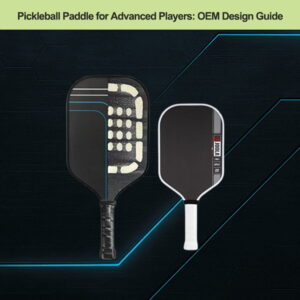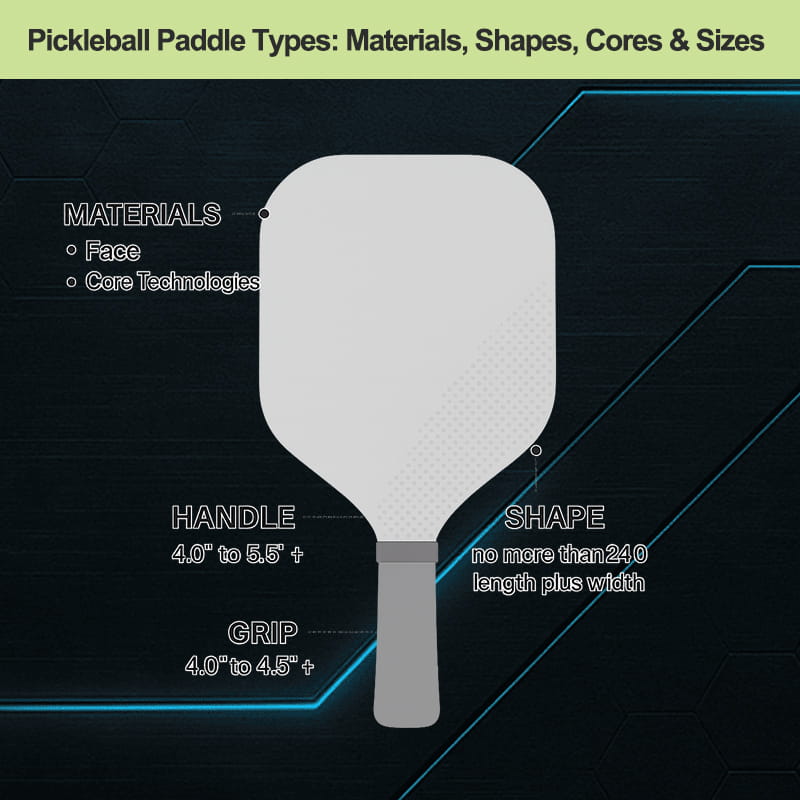
A wall full of pickleball paddles can look confusing at first—but every paddle is built with a purpose. Each one is designed to offer a different mix of power, control, comfort, and durability. These differences come from how the paddle is made—its face material, core, shape, and weight.
By understanding these features, you can quickly tell which paddles are best for beginners, which suit competitive players, and which ones will sell best in your market. This knowledge makes it easier to choose the right paddles for your business—and for your customers.
Four Building Blocks Shape Performance
- Face Material – Think of the face as the speaker of a sound system: carbon fiber and graphite broadcast crisp notes; fiberglass pumps extra bass; Kevlar damps vibration; titanium-carbon hybrids blend warmth with volume.
- Core Technology – The honeycomb or foam core is the amplifier. Nomex pops loudly, polypropylene softens touch, dual-foam cores spread the sweet spot, and GEN-series epoxy fills stiffen the frame for extra punch.
- Shape & Dimensions – Standard and wide-body profiles give you generous forgiveness, while elongated or blade silhouettes add reach and swing speed.
- Balance & Weight – Lightweights (< 7.3 oz) float for fast hand battles; mid-weights (7.4–8.2 oz) feel all-court friendly; heavyweights (8.3 oz+) plow through the ball for deep drives.
Choosing the right types of pickleball paddles is important for anyone buying in bulk—whether for retail stores, private labels, or club programs. Each paddle is built using different materials, shapes, and weights, and these parts affect how the paddle plays and who it’s best for.
This guide makes it simple to understand the key differences. We’ll cover the main materials used for paddle faces and cores, explain common shapes and grip sizes, and show how weight affects performance. Whether you’re stocking your shelves or building your own brand, this article will help you choose the right mix of paddles for all types of players.
PKZK also shares useful tips from our manufacturing process to help you understand what makes a quality paddle—and how to offer the best to your customers.
Key Paddle Face Materials
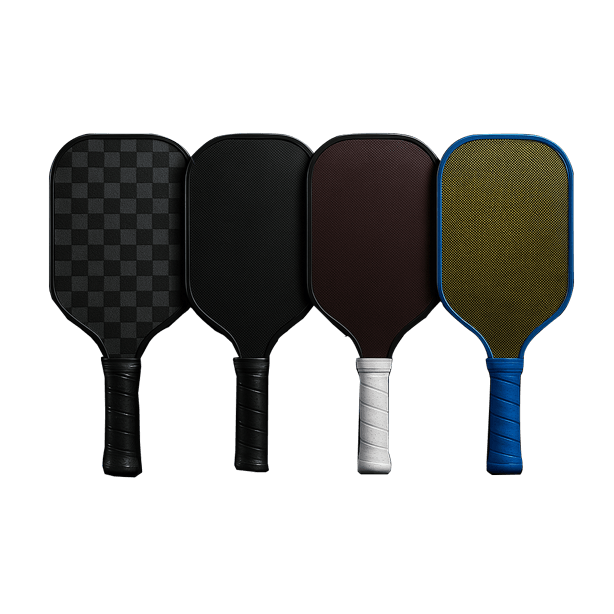
The face material is one of the most important raw materials for a pickleball paddle, directly affecting spin, control, power, and feel. Choosing the right surface helps tailor paddle performance for different player types and price points.
Carbon Fiber Pickleball Paddle
Carbon fiber is one of the most advanced raw materials for a pickleball paddle. Known for its stiffness and strength, it offers high control and consistent touch. Its naturally textured surface also helps generate spin. These paddles are often used by experienced players who prefer precision and responsiveness.
You can view our high-performance carbon fiber pickleball paddle models designed for competitive play.
Key Features:
- Excellent control and accuracy
- Spin-friendly surface texture
- Strong and lightweight
- Durable under heavy use
- Best for intermediate to advanced players
Graphite Pickleball Paddle
While graphite is similar to carbon fiber in look and feel, it’s slightly softer. This gives the paddle a more cushioned response while still maintaining solid control. A graphite pickleball paddle is a great option for players who want a lighter touch with good consistency.
Key Features:
- Smooth and comfortable feel
- Lighter impact, less fatigue
- Balanced control
- Great for control-based play
- Suitable for all skill levels
Fiberglass Pickleball Paddle
Fiberglass is a more flexible raw material often used in paddles aimed at beginner and intermediate players. It creates more rebound on contact, delivering extra power. These paddles typically fall in a more affordable price range and are popular for recreational use.
Explore our range of fiberglass pickleball paddle models, built for power and comfort.
Key Features:
- More power due to flexible face
- Slightly heavier feel
- Great value price point
- Forgiving response for new players
- Ideal for entry-level and casual play
Composite & Hybrid Face Materials
Composite paddles combine raw materials like fiberglass, carbon fiber, or Kevlar to fine-tune the paddle’s performance. These hybrid designs can be engineered to target specific player needs—like more power, improved feel, or greater shock absorption.
Key Features:
- Custom performance blends
- Balanced power and control
- Adjustable to target player styles
- Ideal for mid-tier to advanced players
Kevlar Pickleball Paddle
Kevlar is known for its toughness and ability to absorb vibration. A Kevlar pickleball paddle is ideal for players who want strong impact feel with minimal shock to the hand or arm. Though less common, Kevlar paddles are gaining popularity among competitive players and those with joint sensitivity.
Key Features:
- High vibration dampening
- Strong and durable under pressure
- Softer feel on impact
- Premium quality and price range
Titanium-Carbon Hybrid Face
This innovative face combines titanium’s strength with the controlled surface of carbon fiber. The result is a powerful, responsive paddle that resists wear and delivers consistent spin over time. The titanium-carbon hybrid pickleball paddle is an emerging category with high appeal among aggressive players.
Key Features:
- Extreme durability
- Balanced touch and power
- Maintains performance longer
- Best for high-performance use
Choosing the right raw material for a pickleball paddle is one of the most important steps when building a product line or selecting bulk inventory. Each material brings its own set of features and advantages—and the best-selling paddles are often those that pair the right material with the right audience.
Core Technologies Explained
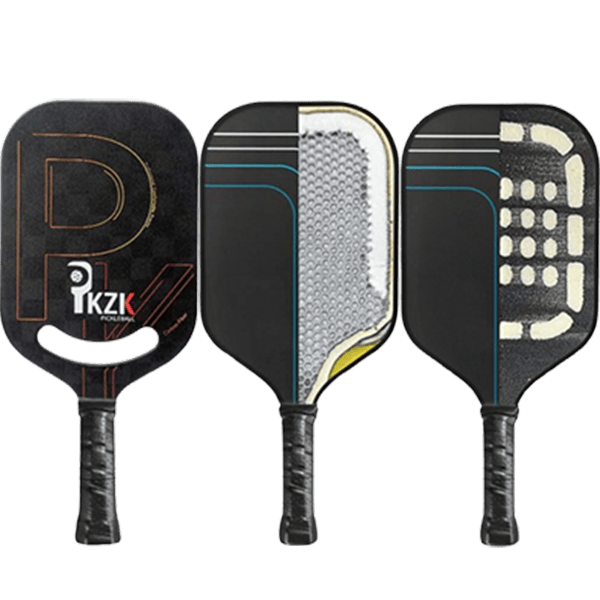
The paddle core is the hidden engine that drives performance. It affects how the paddle feels in your hand, how much power it delivers, how loud it sounds, and how much vibration it sends back. For anyone sourcing or selling paddles, choosing the right raw material for a pickleball paddle core helps build a line that serves players at every level—from beginners to professionals.
Nomex Honeycomb Core
Made from a hard resin-coated paper material, Nomex offers a firm, fast response and a loud “pop” sound. It’s lightweight and ideal for aggressive players who want quick rebounds and strong shots.
A popular core for power-focused models.
Polypropylene Honeycomb Core
Soft, quiet, and forgiving—polypropylene is the most widely used core material in the market. It cushions shots, reduces vibrations, and offers excellent control. This makes it a top choice for casual, beginner, and intermediate paddles.
Essential for comfort-focused, all-around paddle lines.
Titanium-Carbon Hybrid Core
The titanium pickleball paddle core blends lightweight strength with advanced stiffness. By combining titanium and carbon layers in the core structure, it delivers added power and responsiveness without increasing weight.
Perfect for competitive players and high-performance product tiers.
GEN 3–3.5 Dual Foam Core
Used in many Gen 3 pickleball paddle models, this core combines traditional honeycomb with injected foam along the edges. The result is a larger sweet spot, improved shot consistency, and enhanced control on off-center hits.
Ideal for players wanting a balanced mix of control and forgiveness.
GEN 4 Foam Core with Epoxy Resin Filling
Featured in the latest Gen 4 pickleball paddle designs, this core includes high-density foam and epoxy resin to create a more stable and durable hitting surface. It reduces vibration, increases dwell time, and gives a softer yet powerful response.
Designed for advanced players and premium paddle collections.
By understanding these core technologies, you can build or stock paddles that truly match your audience’s needs—whether that’s quiet control for beginners or explosive power for seasoned competitors.
Pickleball Paddle Shape
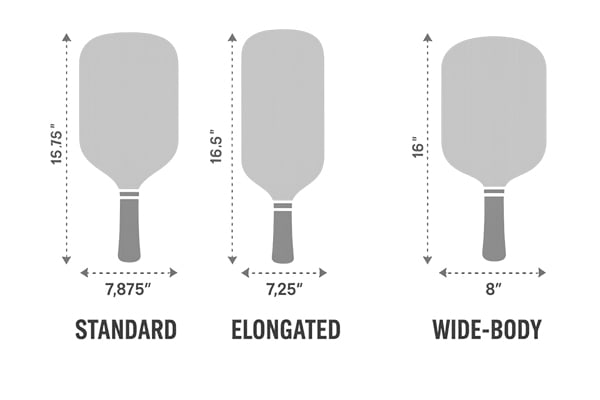
The shape of a pickleball paddle has a direct impact on reach, sweet spot size, balance, and swing feel. For bulk orders and branded collections, offering a variety of shapes allows you to meet the needs of different player types—whether they prioritize control, speed, or extra reach. Here’s how the most common paddle shapes compare.
Standard Shape
The standard paddle shape is typically around 15.5 inches long and 7.8 inches wide. It offers a balanced feel with a medium-sized sweet spot and is ideal for all-around play.
Recommended for beginners and intermediate players who want consistency and control.
Elongated Shape
Elongated paddles are longer (up to 17 inches) and slightly narrower. This design gives players extended reach and more leverage, making it easier to generate power and spin.
Best for advanced players and singles matches where court coverage is key.
Blade & Thin-Body Shape
Blade paddles are slimmer and lighter, with faster swing speeds and lower drag. They excel in quick exchanges at the net and give a faster response time.
Ideal for doubles players who prioritize quick reactions and hand speed.
Wide-Body Shape
With a wider face and shorter length, wide-body paddles provide the largest sweet spot of any design. They offer high forgiveness on mishits and a more stable feel.
Perfect for beginners or players looking for confidence and control on every swing.
Offering multiple paddle shapes in your lineup ensures coverage across playing styles and skill levels. It also helps your customers find paddles that match their performance goals, whether they play at the net, from the baseline, or across the entire court.
Pickleball Paddle Grip Size
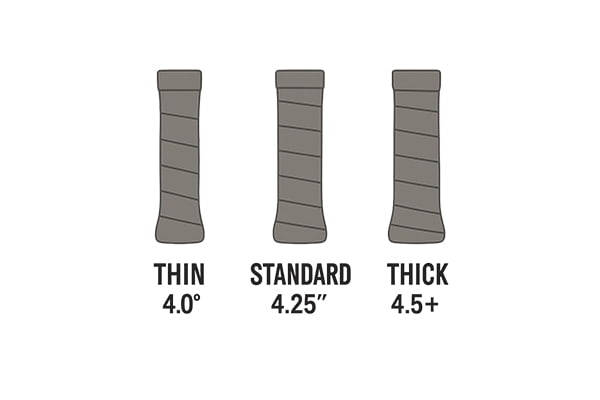
Grip size is a critical but often overlooked factor when selecting or designing a paddle. It directly affects how comfortable the paddle feels in the player’s hand, and more importantly, how much control they have over their shots. For bulk buyers and custom brand lines, offering a range of grip sizes ensures better fit and performance for a wide variety of customers.
Thin Grip
Thin grips (typically around 4.0″ in circumference) are ideal for players with smaller hands or those who prefer more wrist action and paddle control. They allow quicker adjustments and better spin generation but may provide less overall stability.
Best for juniors, smaller adults, and spin-focused players.
Standard Grip
Standard grips range from 4.25″ to 4.375″ and are the most commonly used across all skill levels. They offer a good balance of comfort, control, and stability, making them a safe and versatile choice for most paddles.
Ideal for general use across your product range.
Thick Grip
Thicker grips (around 4.5″ or more) provide a more solid, cushioned feel. They help reduce strain on the wrist and forearm and are often preferred by players with larger hands or those recovering from injury.
Recommended for senior players or those seeking comfort and extra grip support.
Offering multiple grip sizes across your paddle models allows you to meet diverse player needs and expand your target audience. To dive deeper into how grip size relates to total paddle build—including handle and face dimensions—explore our detailed guide on the size of pickleball paddle, where we break down how each measurement impacts play.
Pickleball Paddle Handle Lengths
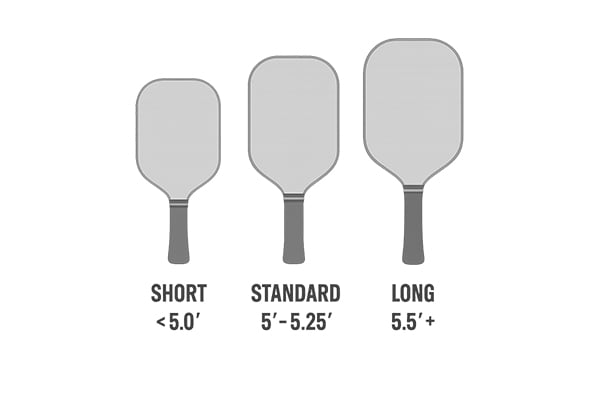
Handle length affects paddle balance, comfort, and performance. Offering paddles with different handle lengths ensures your product line suits diverse playing styles and customer needs. Below are the most common categories, based on industry and USA Pickleball standards:
Short Handle (< 5.0 inches)
Typically between 4.0″ and 4.75″, short handles allow the paddle face to take up more of the 24″ maximum paddle length. This increases the sweet spot and improves maneuverability—ideal for net play and slower swings.
Recommended for wide-body paddles and beginner-focused models.
Standard Handle (5.0″ – 5.25″)
The most common length in pickleball, offering a balanced experience of control and reach .
Perfect for all-around paddles aimed at general-use and mid-tier performance lines.
Long Handle (5.25″ – 5.5″+)
At 5.25″ to 5.5″ or more, long-handled paddles provide extended reach and leverage—useful for two-handed backhands and added power. The trade-off is a slightly smaller hitting surface to stay within overall length limits.
Ideal for advanced players, tennis crossover athletes, and power-focused models.
Summary Table
| Handle Type | Range | Benefits | Best For |
| Short | < 5.0″ | Larger sweet spot, quick control | Beginners, wide-body paddles |
| Standard | 5.0″–5.25″ | Balanced feel and reach | General-use and mid-tier paddles |
| Long | > 5.25″ | Extended reach, more leverage | Advanced players, two-handed backhands |
Selecting the right handle length is another way to fine-tune the overall size of a pickleball paddle for specific players. When building or stocking a paddle collection, be sure to offer options across this range to match customer expectations—whether for better grip, more comfort, or specialized playing styles.
Pickleball Paddle Weight
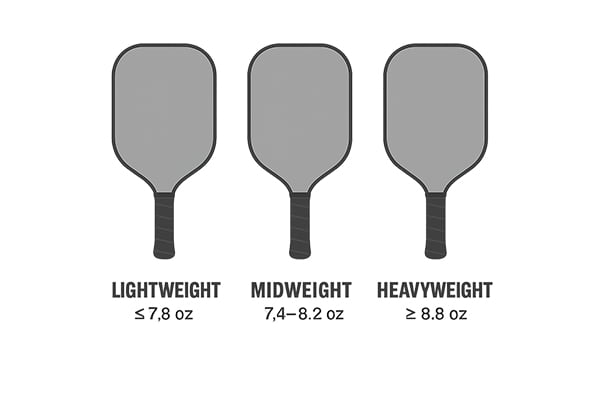
Weight is one of the most important factors when it comes to how a paddle performs. It affects swing speed, power, control, and fatigue. For retailers and brands, offering a range of paddle weights ensures you’re meeting the needs of all players—from casual beginners to serious competitors.
Lightweight Paddles (7.0 oz – 7.3 oz)
Lightweight paddles are easy to maneuver and reduce arm strain, especially during long games. They’re ideal for quick net play, fast hand exchanges, and players who prefer control over raw power.
Best for junior players, seniors, and those with wrist or elbow concerns.
Midweight Paddles (7.4 oz – 8.2 oz)
This is the most popular weight class on the market. Midweight paddles strike a solid balance between power and control, making them suitable for a wide range of players and playing styles.
Recommended for general use, recreational leagues, and multi-skill-level offerings.
Heavyweight Paddles (8.3 oz and above)
Heavy paddles generate more power with less effort, especially from the baseline. They’re perfect for aggressive players who want deeper drives and harder hits—but can cause fatigue if used for extended periods without proper technique.
Ideal for power-focused players and former tennis athletes.
Choosing the right paddle weight depends on player preference, playing style, and physical ability. That’s why offering lightweight, midweight, and heavyweight options in your product line helps maximize appeal across different user segments. When combined with grip size and core technology, weight becomes a key selling point in building high-performing, high-demand paddles.
Pickleball Paddle Selection by Player Type
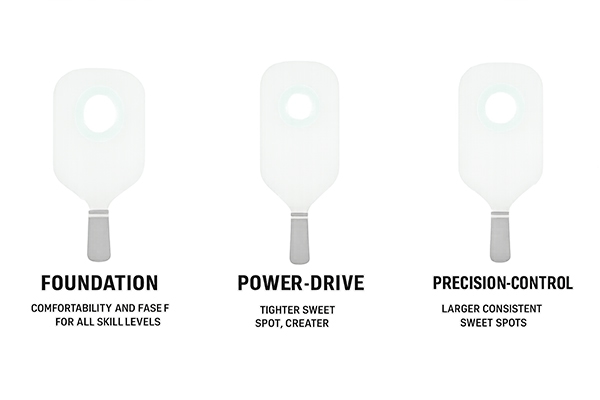
Different players need different paddle designs. By understanding how paddle features match playing styles and skill levels, you can build a more effective product line for clubs, retailers, or custom-branded orders. Below are three core player profiles and the paddle styles that best serve them—using fresh, unique naming categories.
Foundation Players
These are new or casual players who prioritize comfort, easy handling, and forgiving paddle response. The best paddles for this group are midweight, with polypropylene cores, wide-body shapes, and standard grip sizes. A soft fiberglass or graphite face offers a smooth feel and helps new players build control.
Focus: Stability, comfort, and ease of use.
Power-Drive Players
These are competitive or athletic players who favor aggressive, fast-paced play. They benefit from paddles with elongated shapes, Nomex or hybrid cores, and heavier weights. Using stiffer surfaces like fiberglass or titanium-carbon hybrids, these paddles are designed to amplify speed and shot strength.
Focus: Maximum drive, fast swing speed, and spin potential.
Explore our titanium pickleball paddle and Gen 3 pickleball paddle options for this player type.
Precision-Control Players
These players rely on finesse and placement over force. Paddles for this group should feature rounded or standard shapes, thicker foam cores (like Gen 4 epoxy-infused), and light to midweight builds. Materials like carbon fiber or textured graphite help increase touch and accuracy, especially during soft play or dinking.
Focus: Accuracy, soft feel, and reliable shot control.
Explore our Gen 4 pickleball paddle lineup made for control-first performance.
By tailoring your paddle selection to specific player needs—beginners, power players, and precision control players—you create a more targeted, easy-to-navigate buying experience. This approach helps maximize product value, improve customer satisfaction, and boost long-term brand loyalty.
Conclusion
Choosing the right mix of types of pickleball paddles is key for any business looking to succeed in today’s fast-growing pickleball market. From surface materials like carbon fiber or fiberglass, to core types, paddle shapes, weights, and handle designs—every feature influences how a paddle performs and who it’s best suited for.
As a professional pickleball paddle manufacturer, PKZK understands how to align product design with player demand. Whether you’re sourcing for retail, launching your own line, or managing inventory for a club or online store, we offer high-quality custom pickleball paddles in bulk that match your exact needs.
With flexible customization and reliable production, PKZK helps your business stand out in the growing pickleball market. Let us support your next paddle line with quality, consistency, and expert service.

